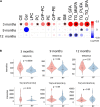Impact of Extensively Hydrolyzed Infant Formula on Circulating Lipids During Early Life
- PMID: 35685890
- PMCID: PMC9171511
- DOI: 10.3389/fnut.2022.859627
Impact of Extensively Hydrolyzed Infant Formula on Circulating Lipids During Early Life
Abstract
Background: Current evidence suggests that the composition of infant formula (IF) affects the gut microbiome, intestinal function, and immune responses during infancy. However, the impact of IF on circulating lipid profiles in infants is still poorly understood. The objectives of this study were to (1) investigate how extensively hydrolyzed IF impacts serum lipidome compared to conventional formula and (2) to associate changes in circulatory lipids with gastrointestinal biomarkers including intestinal permeability.
Methods: In a randomized, double-blind controlled nutritional intervention study (n = 73), we applied mass spectrometry-based lipidomics to analyze serum lipids in infants who were fed extensively hydrolyzed formula (HF) or conventional, regular formula (RF). Serum samples were collected at 3, 9, and 12 months of age. Child's growth (weight and length) and intestinal functional markers, including lactulose mannitol (LM) ratio, fecal calprotectin, and fecal beta-defensin, were also measured at given time points. At 3 months of age, stool samples were analyzed by shotgun metagenomics.
Results: Concentrations of sphingomyelins were higher in the HF group as compared to the RF group. Triacylglycerols (TGs) containing saturated and monounsaturated fatty acyl chains were found in higher levels in the HF group at 3 months, but downregulated at 9 and 12 months of age. LM ratio was lower in the HF group at 9 months of age. In the RF group, the LM ratio was positively associated with ether-linked lipids. Such an association was, however, not observed in the HF group.
Conclusion: Our study suggests that HF intervention changes the circulating lipidome, including those lipids previously found to be associated with progression to islet autoimmunity or overt T1D.
Clinical trial registration: [Clinicaltrials.gov], identifier [NCT01735123].
Keywords: early life; extensively hydrolyzed infant formula; intestinal permeability; lipidome; lipidomics; metabolomics.
Copyright © 2022 Lamichhane, Siljander, Salonen, Ruohtula, Virtanen, Ilonen, Hyötyläinen, Knip and Orešič.
Conflict of interest statement
The authors declare that the research was conducted in the absence of any commercial or financial relationships that could be construed as a potential conflict of interest.
Figures



Similar articles
-
Effect of Early Feeding on Intestinal Permeability and Inflammation Markers in Infants with Genetic Susceptibility to Type 1 Diabetes: A Randomized Clinical Trial.J Pediatr. 2021 Nov;238:305-311.e3. doi: 10.1016/j.jpeds.2021.07.042. Epub 2021 Jul 20. J Pediatr. 2021. PMID: 34293372 Clinical Trial.
-
Stool microbiome, pH and short/branched chain fatty acids in infants receiving extensively hydrolyzed formula, amino acid formula, or human milk through two months of age.BMC Microbiol. 2020 Nov 9;20(1):337. doi: 10.1186/s12866-020-01991-5. BMC Microbiol. 2020. PMID: 33167908 Free PMC article. Clinical Trial.
-
Infant Formula With a Specific Blend of Five Human Milk Oligosaccharides Drives the Gut Microbiota Development and Improves Gut Maturation Markers: A Randomized Controlled Trial.Front Nutr. 2022 Jul 6;9:920362. doi: 10.3389/fnut.2022.920362. eCollection 2022. Front Nutr. 2022. PMID: 35873420 Free PMC article.
-
The Metagenomic and Metabolomic Profile of the Infantile Gut: Can They Be "Predicted" by the Feed Type?Children (Basel). 2022 Jan 25;9(2):154. doi: 10.3390/children9020154. Children (Basel). 2022. PMID: 35204875 Free PMC article. Review.
-
Comparison of Growth of Healthy Term Infants Fed Extensively Hydrolyzed Protein- and Amino Acid-Based Infant Formulas.Nutrients. 2018 Mar 1;10(3):289. doi: 10.3390/nu10030289. Nutrients. 2018. PMID: 29494498 Free PMC article. Review.
Cited by
-
Chewing the fat: How lipidomics is changing our understanding of human health and disease in 2022.Anal Sci Adv. 2023 May 10;4(3-4):104-131. doi: 10.1002/ansa.202300009. eCollection 2023 May. Anal Sci Adv. 2023. PMID: 38715925 Free PMC article. Review.
-
Serum proteomics of mother-infant dyads carrying HLA-conferred type 1 diabetes risk.iScience. 2024 May 22;27(6):110048. doi: 10.1016/j.isci.2024.110048. eCollection 2024 Jun 21. iScience. 2024. PMID: 38883825 Free PMC article.
References
-
- Kramer MS, Kakuma R. Optimal duration of exclusive breastfeeding. Cochrane Database Syst Rev. (2012) 2012:Cd003517. - PubMed
Associated data
LinkOut - more resources
Full Text Sources
Medical
Research Materials
Miscellaneous

